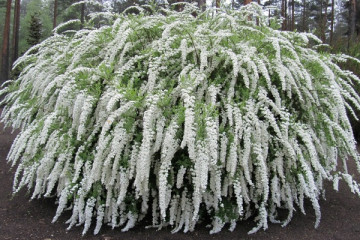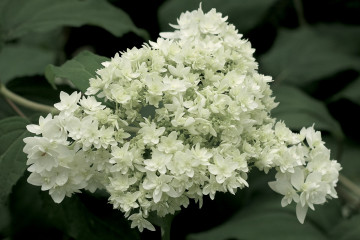Kalistegiya - landing and leaving. Description of varieties
Content:
Calistegia is a perennial plant belonging to the Bindweed family. Long flowering, unpretentious care, winter hardiness and beautiful appearance of the buds have made this flower popular in landscape gardening design.
Characteristics of calistegia: varieties and varieties
Kalistegia also has one more name - "new fence". This flower is a loach with a long slender stem, the length of which can reach 4 m. On a curling stem, arrow-shaped or heart-shaped leaves are located on long petioles. In almost every sinus, a bud appears on the stem, the corolla of which reaches 5-6 cm. Some species are characterized by large flowers (up to 10 cm).
The plant has many types. Some of them were bred by selection. The most common varieties are used universally.
Calistegia fluffy
The variety is considered the largest representative of its genus. It was she who was used in the development of new varieties. This plant is distinguished by large, pale pink buds with a delicate aroma, but it is most often found in China.
Calistegia Flore Captivity
The variety was bred as a result of selection and it was he who became widespread in Russia, which is explained by its resistance to temperature extremes. The stem is up to 3 m long, all covered with large pink buds. Leaves of this kind are arrow-shaped, covered with hairs.
Intake calistegia
The flower is widespread in central Russia as a wild plant. On a thin stem are arrow-shaped leaves and pink-white flowers in the form of a gramophone.
Terry calistegia
It includes all terry varieties. On a long stem, large pink buds open among the dark green leaves. Florists often call this variety "French rose".
Japanese calistegia (ivy)
This variety is distinguished by three-lobed leaves, small stems (up to 2.5 m) and a multi-tiered slightly disheveled bud.
Planting a plant
The plant can be planted in two ways:
- Seeds. Used by flower growers extremely rarely.
- Seedlings. The method has a number of advantages, which is why it is used everywhere.
To decide which of the planting methods is best, it is worth examining the characteristics of each.
Seed planting
Hybrid varieties are not recommended to be planted with seeds, as such seedlings will not inherit maternal traits. In addition, seed germination takes longer and does not guarantee germination. Most often, new ones are sold as seedlings.
Planting seedlings
Work on planting Kalistegia vines in the ground is performed in the following sequence:
- Choose a suitable place to grow the bindweed. There should be a sunny area or a place with partial shade.
- Dig a trench. Its depth should be no less than the bayonet of a shovel.
- The dug trench is filled with soil with the addition of humus, ash and mineral fertilizers.
- Seedlings are planted in a trench with a step of 5-25 cm (this depends on the type of plant).
Watering and loosening the soil
In arid regions, bindweed should be watered periodically, but moisture should not stagnate in the soil. Waterlogging negatively affects the growth and flowering of the poyv.
If calistegia is grown in southern and temperate latitudes, then additional watering is not required for it. Powerful rhizomes are able to extract moisture on their own. From time to time, the soil in the root zone needs to be loosened. This ensures a constant flow of air to the plant.
Reproduction methods
Best of all, the Siberian rose calistegia propagates by rhizomes (not tubers). It is necessary to prepare planting material in the fall. To do this, dig out the rhizome and place it in a box filled with soil. The soil in this box should remain slightly moist all the time, and the air in the room should be cool.
In the spring in March, the rhizome is freed from the soil and cut into small pieces. The size of each can reach 5-7 cm. The sections are processed with charcoal or ash. Prepared pieces of roots are planted in boxes with earth or peat pots. It is necessary to deepen the planting material no more than 3-5 cm. Immediately after that, the soil must be moistened, but not allowed to excess moisture.
Top dressing and fertilizers
Curly calistegia is characterized by a long flowering period, so the plant needs fertile soil. During the season, flowers need to be fertilized several times:
- The first feeding occurs at the beginning of growth (even before the buds appear). Humus and organic fertilizers are added to the soil.
- In summer, during the flowering period, top dressing is carried out every 2 weeks. Mineral formulations are best suited for this purpose.
- Ash is added to the soil in late autumn.
Plant transplant
Transplanting this plant in summer is highly discouraged, as new bushes will be poorly accepted. In this case, there is a risk of death of the flower. Transplanted in spring or autumn, new shoots will take root and grow.
Pruning calistegia
During the entire period of growth and flowering, the new one needs care, including pruning. All thin shoots and wilted buds are subject to removal. This thinning makes the flowering abundant and helps maintain the beauty and freshness of the bush.
Pests and diseases
The calistegia flower is most often affected by the following pests:
- Spider mite. If the weather is hot, then spider mites can settle on the leaves. You can fight them with Aktar or other acaricidal drugs.
- Slugs. To eliminate such pests, it is recommended to treat the plant with insecticides (for example, Thunderstorm). Another important requirement is lime sprinkling of the soil.
How to care for a plant during flowering
Terry Kalistegiya when growing requires a minimum of time and effort. At the same time, the plant blooms actively from spring to late autumn. That is why such a bindweed is recommended for summer residents and novice flower growers. However, some recommendations are still worth following. Among them:
- watering if necessary;
- feeding every 2 weeks;
- periodic removal of wilted buds.
If you take care of the flower with these recommendations in mind, the vine will bloom continuously.
Preparing for winter
The povoy belongs to perennials, which is why the plant must be carefully prepared for winter. After the end of flowering, the stem is cut off. Leave about 1/3 of its total length. Some advise you to cut off the entire stem, leaving only a small stump. The soil in the root zone is sprinkled with ash. The flowers have relatively high frost resistance.
Use in landscape design
Many varieties of bindweed plants effectively fit into landscape design:
- The hedge with a whisper planted along it looks beautiful and original.
- Stems of ivy calistegia can braid gazebos, walls and arches. Due to this, building structures look more attractive and hide from prying eyes.
- A single planting of several plants can replace a flower bed.
Such a plant is widely demanded not only in the gardens of Russia, but also in the territory of the post-Soviet space. This is explained by the fact that planting a calistegia and leaving in the open field requires a minimum of effort, while the buds are comparable in beauty to peonies and roses.



















